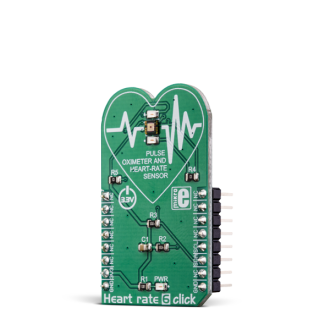
We strongly encourage users to use Package manager for sharing their code on Libstock website, because it boosts your efficiency and leaves the end user with no room for error. [more info]

Rating:
Author: MIKROE
Last Updated: 2018-11-09
Package Version: 1.0.0.0
mikroSDK Library: 1.0.0.0
Category: Biometrics
Downloaded: 5228 times
Not followed.
License: MIT license
Heart rate 6 click is an optical biosensor Click board designed for heart-rate monitoring (HRM).
Do you want to subscribe in order to receive notifications regarding "Heart rate 6 click" changes.
Do you want to unsubscribe in order to stop receiving notifications regarding "Heart rate 6 click" changes.
Do you want to report abuse regarding "Heart rate 6 click".


Library Description
Library performs the control of the Heart rate 6 Click board via I2C interface. Library offers a choice to perform a device configuration and a measurement wait time period, and then can read LED Data. For more details check documentation.
Key functions:
void uint8_t heartrate6_writeSingleByte( uint8_t regAddr, uint8_t dataIn ) - Function writes one byte to the register.void uint8_t heartrate6_readBytes( uint8_t startAddr, uint8_t *dataOut, uint8_t nBytes ) - Function reads the desired number of bytes from the registers.void void heartrate6_getData( uint16_t *ledOffData, uint16_t *ledOnData ) - Function reads the LED Data as 16bit unsigned value.Examples description
The application is composed of the three sections :
void applicationTask()
{
heartrate6_waitMeasure();
heartrate6_getData( &ledDataOFF, &ledDataON );
plotRes( ledDataON );
}
Additional Functions :
Other mikroE Libraries used in the example:
ConversionsI2CUARTAdditional notes and information
Depending on the development board you are using, you may need USB UART click, USB UART 2 click or RS232 click to connect to your PC, for development systems with no UART to USB interface available on the board. The terminal available in all MikroElektronika compilers, or any other terminal application of your choice, can be used to read the message.